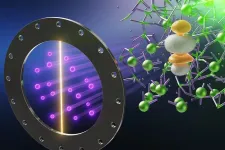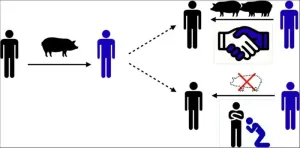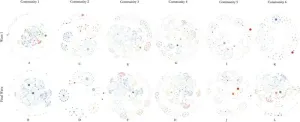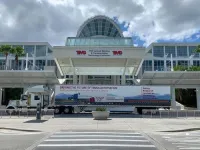(Press-News.org) Assorted, distinctive behavior of molten uranium salt revealed by neutrons
The Department of Energy’s Oak Ridge National Laboratory is a world leader in molten salt reactor technology development — and its researchers additionally perform the fundamental science necessary to enable a future where nuclear energy becomes more efficient. In a recent paper published in the Journal of the American Chemical Society, researchers have documented for the first time the unique chemistry dynamics and structure of high-temperature liquid uranium trichloride (UCl3) salt, a potential nuclear fuel source for next-generation reactors.
“This is a first critical step in enabling good predictive models for the design of future reactors,” said ORNL’s Santanu Roy, who co-led the study. “A better ability to predict and calculate the microscopic behaviors is critical to design, and reliable data help develop better models.”
For decades, molten salt reactors have been expected to possess the capacity to produce safe and affordable nuclear energy, with ORNL prototyping experiments in the 1960s successfully demonstrating the technology. Recently, as decarbonization has become an increasing priority around the world, many countries have re-energized efforts to make such nuclear reactors available for broad use.
Ideal system design for these future reactors relies on an understanding of the behavior of the liquid fuel salts that distinguish them from typical nuclear reactors that use solid uranium dioxide pellets. The chemical, structural and dynamical behavior of these fuel salts at the atomic level are challenging to understand, especially when they involve radioactive elements such as the actinide series — to which uranium belongs — because these salts only melt at extremely high temperatures and exhibit complex, exotic ion-ion coordination chemistry.
The research, a collaboration among ORNL, Argonne National Laboratory and the University of South Carolina, used a combination of computational approaches and an ORNL-based DOE Office of Science user facility, the Spallation Neutron Source, or SNS, to study the chemical bonding and atomic dynamics of UCl3 in the molten state.
The SNS is one of the brightest neutron sources in the world, and it allows scientists to perform state-of-the-art neutron scattering studies, which reveal details about the positions, motions and magnetic properties of materials. When a beam of neutrons is aimed at a sample, many neutrons will pass through the material, but some interact directly with atomic nuclei and “bounce” away at an angle, like colliding balls in a game of pool.
Using special detectors, scientists count scattered neutrons, measure their energies and the angles at which they scatter, and map their final positions. This makes it possible for scientists to glean details about the nature of materials ranging from liquid crystals to superconducting ceramics, from proteins to plastics, and from metals to metallic glass magnets.
Each year, hundreds of scientists use ORNL’s SNS for research that ultimately improves the quality of products from cell phones to pharmaceuticals — but not all of them need to study a radioactive salt at 900 degrees Celsius, which is as hot as volcanic lava. After rigorous safety precautions and special containment developed in coordination with SNS beamline scientists, the team was able to do something no one has done before: measure the chemical bond lengths of molten UCl3 and witness its surprising behavior as it reached the molten state.
“I’ve been studying actinides and uranium since I joined ORNL as a postdoc,” said Alex Ivanov, who also co-led the study, “but I never expected that we could go to the molten state and find fascinating chemistry.”
What they found was that, on average, the distance of the bonds holding the uranium and chlorine together actually shrunk as the substance became liquid — contrary to the typical expectation that heat expands and cold contracts, which is often true in chemistry and life. More interestingly, among the various bonded atom pairs, the bonds were of inconsistent size, and they stretched in an oscillating pattern, sometimes achieving bond lengths much larger than in solid UCl3 but also tightening to extremely short bond lengths. Different dynamics, occurring at ultra-fast speed, were evident within the liquid.
“This is an uncharted part of chemistry and reveals the fundamental atomic structure of actinides under extreme conditions,” said Ivanov.
The bonding data were also surprisingly complex. When the UCl3 reached its tightest and shortest bond length, it briefly caused the bond to appear more covalent, instead of its typical ionic nature, again oscillating in and out of this state at extremely fast speeds — less than one trillionth of a second.
This observed period of an apparent covalent bonding, while brief and cyclical, helps explain some inconsistencies in historical studies describing the behavior of molten UCl3. These findings, along with the broader results of the study, may help improve both experimental and computational approaches to the design of future reactors.
Moreover, these results improve fundamental understanding of actinide salts, which may be useful in tackling challenges with nuclear waste, pyroprocessing. and other current or future applications involving this series of elements.
The research was part of DOE’s Molten Salts in Extreme Environments Energy Frontier Research Center, or MSEE EFRC, led by Brookhaven National Laboratory. The research was primarily conducted at the SNS and also used two other DOE Office of Science user facilities: Lawrence Berkeley National Laboratory’s National Energy Research Scientific Computing Center and Argonne National Laboratory’s Advanced Photon Source. The research also leveraged resources from ORNL’s Compute and Data Environment for Science, or CADES.
UT-Battelle manages ORNL for DOE’s Office of Science, the single largest supporter of basic research in the physical sciences in the United States. The Office of Science is working to address some of the most pressing challenges of our time. For more information, please visit energy.gov/science. — Emily Tomlin
END
Assorted, distinctive behavior of molten uranium salt revealed by neutrons
2024-09-03
ELSE PRESS RELEASES FROM THIS DATE:
NASA's mini BurstCube mission detects mega blast
2024-09-03
The shoebox-sized BurstCube satellite has observed its first gamma-ray burst, the most powerful kind of explosion in the universe, according to a recent analysis of observations collected over the last several months.
“We’re excited to collect science data,” said Sean Semper, BurstCube’s lead engineer at NASA’s Goddard Space Flight Center in Greenbelt, Maryland. “It’s an important milestone for the team and for the many early career engineers and scientists that have been part of the mission.”
The ...
ESMO Congress 2024
2024-09-03
Lugano, Switzerland, 3 September 2024 – The ESMO Congress 2024 will take place from September 13-17 in Barcelona, bringing together participants from all over the world. Press representatives eager to grasp cutting-edge data and hearing expert perspectives on the latest research, as well as on the current and emerging hot topics in oncology, are invited to attend the event, which will be held both onsite and remotely.
The full congress program is available online to help press representatives browse regular and late-breaking abstract ...
Prestigious NSF award to advance UK research to track emerging pathogens
2024-09-03
We all have lived through a pandemic, its uncertainties, challenges, losses and scientific breakthroughs. A prestigious award from the U.S. National Science Foundation (NSF) is advancing the work of a team of researchers at the University of Kentucky to help society be better prepared for potential future pandemics.
Scott Berry, Ph.D., an associate professor in the Department of Mechanical and Aerospace Engineering in the UK Stanley and Karen Pigman College of Engineering, is the principal investigator ...
NIH awards will support innovation in syphilis diagnostics
2024-09-03
The National Institutes of Health’s National Institute of Allergy and Infectious Diseases (NIAID) has awarded grants for 10 projects to improve diagnostic tools for congenital and adult syphilis—conditions currently diagnosed with a sequence of tests, each with limited precision. The Centers for Disease Control and Prevention (CDC) estimates that adult and congenital syphilis cases increased by 80% and 183% respectively between 2018 and 2022—a crisis that prompted the U.S. Department of Health and Human Services (HHS) to establish a national taskforce to respond to the epidemic.
“Syphilis ...
Explaining the mechanism of social evolution driven by gift giving
2024-09-03
New findings provide quantitative criteria for classifying social organizations in human history, together with potential explanatory variables that can be empirically measured for anthropology, history, and archaeology, according to a study published September 3, 2024 in the open-access journal PLOS Complex Systems by Kenji Itao and Kunihiko Kaneko from the University of Tokyo, Japan and Copenhagen University, Denmark (Kaneko) and the RIKEN Center for Brain Science, Japan (Itao).
Human societies have experienced transitions between different types of organizations, including bands, tribes, chiefdoms, and kingdoms. However, quantitative characterizations of the types and mechanisms of ...
How do new words arise in social media?
2024-09-03
The more centrally connected someone is within their social media network, the more likely that new words they use will become adopted into mainstream language, according to a new study published this week in PLOS Complex Systems by Louise Tarrade of École Normale Supérieure, France, and colleagues.
Language evolves within a social context and variations in a language are always in competition with each other. In everyday language, words are constantly being created, but not all these words persist.
In the new study, researchers analyzed more than 650 million tweets written in French between 2012 and 2014 to identify ...
In US community efforts to prevent childhood obesity, women leaders with more experience and connections have the greatest impact
2024-09-03
In US community efforts to prevent childhood obesity, women leaders with more experience and connections have the greatest impact.
####
In your coverage, please use this URL to provide access to the freely available article in PLOS Complex Systems: https://journals.plos.org/complexsystems/article?id=10.1371/journal.pcsy.0000004
Article Title: Determinants and facilitators of community coalition diffusion of prevention efforts
Author Countries: United States
Funding: TM, MP, and CE received funding from the ...
Guidelines to steer the future of autonomous trucking
2024-09-03
After four years, a guidebook for the future of autonomous trucking has driven across the finish line.
In 2020, the Virginia Tech Transportation Institute (VTTI) and 17 partners were awarded a $7.5 million grant from the U.S. Department of Transportation to develop a concept of operations. The final report, published in July, includes best practices for the implementation of automated driving systems (ADS) in large trucks and policy issues for fleets to consider across eight topic areas.
“We’re excited that the Federal Motor Carrier ...
From cavities to sleep apnea: dentists can assume new role in saving lives
2024-09-03
A patient dozes off in a dental chair despite the anxiety of an impending procedure. A seemingly unremarkable act but — for dentists versed in the latest sleep research — this red flag hints at a life-threatening condition.
In a research review published in the Journal of the American Dental Association, Rutgers Health researchers identified dentists as an unexpected player in the battle against life-threatening sleep disorders.
The review suggests dental professionals have unique opportunities to screen for conditions such as obstructive sleep apnea, a disorder that affects millions of Americans and is linked to serious health risks, including cardiovascular ...
Department of Energy awards $125 Million for research to enable next-generation batteries and energy storage
2024-09-03
WASHINGTON, D.C. - Today, the U.S. Department of Energy (DOE) announced $125 million in funding for two Energy Innovation Hub teams to provide the scientific foundation needed to seed and accelerate next generation technologies beyond today’s generation of lithium (Li)-ion batteries. These multi-institution research teams, led by Argonne National Laboratory and Stanford University, will develop scientific concepts and understanding to impact decarbonization of transportation and incorporation of clean energy into the electricity grid.
Rechargeable batteries, such as Li-ion and lead-acid batteries, have had a ...







